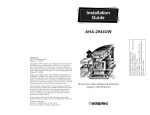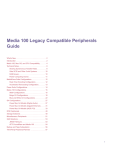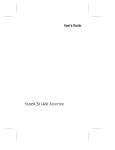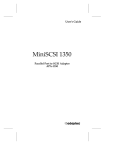Download Adaptec 2940U2W Instruction manual
Transcript
USER’S REFERENCE SCSI CARD 2940U2W © 1997 Adaptec, Inc. All rights reserved. Adaptec, and the Adaptec logo are trademarks of Adaptec, Inc. which may be registered in some jurisdictions. Printed in Singapore STOCK NO.: 511795-00, Rev. A RQ 12/97 ▼ ▼ ▼ ▼ SCSI Card 2940U2W User’s Reference R ▼ ▼ ▼ ▼ Contents Understanding SCSI 1 SCSI IDs 1 SCAM Protocol 2 Terminating the SCSI Bus 3 Troubleshooting 4 Troubleshooting Checklist 4 Troubleshooting in Windows 95 5 Common Error Messages 9 Using the SCSI Card 2940U2W and SCSI Peripherals 10 Using SCSI Peripherals 10 Hard Disk Drives 10 Scanners 11 SCSI Peripheral Display at Bootup 12 Installing Multiple SCSI Cards 12 Connecting the LED Connector 13 Using SCSI and IDE (or EIDE) Peripherals 14 Replacing a Non-Adaptec SCSI Card with an Adaptec SCSI Card 14 Configuring the SCSI Card 2940U2W with SCSISelect 15 Starting SCSISelect 16 Exiting SCSISelect 17 Using SCSISelect Settings 17 Basic Host Adapter Settings 17 Boot Device Options 18 iii SCSI Card 2940U2W User’s Reference SCSI Device Configuration 19 Advanced Configuration Options 20 Using SCSI Disk Utilities 22 Obtaining SCSI Cables and Adapters 23 External Cables 23 External Connector Diagrams 23 Internal Cables 24 Internal Connector Diagrams 24 Cabling Examples 25 Maximum Cable Lengths 27 ❒ iv Understanding SCSI SCSI (pronounced “scuzzy”) stands for Small Computer Systems Interface. SCSI is an industry standard computer interface for connecting SCSI peripherals (such as a hard disk drive, CD-ROM drive, or scanner) to a common SCSI bus. A SCSI bus is an electrical pathway that consists of a SCSI adapter card (such as the SCSI Card 2940U2W) installed in a computer and one or more SCSI peripherals. SCSI cables are used to connect the peripherals to the SCSI adapter card. For the SCSI bus to function properly, SCSI IDs must be assigned to SCSI devices (SCSI peripherals and SCSI card), and the SCSI bus must be properly terminated. SCSI IDs Each peripheral attached to the SCSI Card 2940U2W, as well as the SCSI Card 2940U2W itself, must be assigned a unique SCSI ID number from 0 to 15. A SCSI ID uniquely identifies each SCSI device on the SCSI bus and determines priority when two or more devices are trying to use the SCSI bus at the same time. Refer to the peripheral’s documentation to set the SCSI ID. Here are some general guidelines for SCSI IDs: ■ For internal SCSI peripherals, the SCSI ID usually is set by configuring a jumper on the peripheral. ■ For external SCSI peripherals, the SCSI ID usually is set with a switch on the back of the peripheral. 1 SCSI Card 2940U2W User’s Reference ■ SCSI ID numbers don’t have to be sequential, as long as the SCSI Card 2940U2W and each peripheral has a different number. For example, you can have an internal SCSI peripheral with ID 0, and an external SCSI peripheral with ID 6. Gaps in the sequence of numbers don’t matter. ■ SCSI ID 7 has the highest priority on the SCSI bus. The priority of the remaining IDs, in descending order, is 6 to 0, 15 to 8. ■ The SCSI Card 2940U2W is preset to SCSI ID 7 and should not be changed. This gives it the highest priority on the SCSI bus. ■ Most internal SCSI hard disk drives come from the factory preset to SCSI ID 0. ■ If you have 8-bit SCSI peripherals, they must use SCSI IDs 0, 1, 2, 3, 4, 5, or 6. SCSI ID 0 is recommended for the first SCSI hard disk drive. ■ If you are booting your computer from a SCSI hard disk drive connected to the SCSI Card 2940U2W, the Boot Target ID setting in the SCSISelect utility must correspond to the SCSI ID of the peripheral from which you are booting. By default, the Boot Target ID is set to 0. See Boot Device Options on page 18 to change the Boot Target ID. ■ ■ In Windows® 95, you can use the Device Manager to view the SCSI ID (and other details) assigned to each SCSI device installed. If you installed Adaptec ® EZ-SCSI® software, you can use the SCSI Explorer utility to view the SCSI ID (and other details) assigned to each SCSI device installed. SCAM Protocol The SCSI Card 2940U2W supports the SCSI Configured AutoMatically (SCAM) protocol, which assigns SCSI IDs dynamically and resolves SCSI ID conflicts automatically when you start the computer. If your computer includes SCSI disk drives or other peripherals that support SCAM, you do not need to manually assign SCSI IDs to these peripherals. To enable SCAM support, see Configuring the SCSI Card 2940U2W with SCSISelect on page 15. 2 Understanding SCSI Terminating the SCSI Bus To ensure reliable communication on the SCSI bus, the ends of the SCSI bus must be properly terminated. This is accomplished when the peripheral at the end of each cable, or the end of the cable itself, has a terminator installed (or enabled). The peripherals between the ends of each cable must have its terminator removed (or disabled). Since the method for terminating a SCSI peripheral can vary widely, refer to the peripheral’s documentation for instructions on how to enable or disable termination. Here are some general guidelines for termination: ■ Termination on internal SCSI peripherals usually is controlled by manually setting a jumper or a switch on the peripheral, or by physically removing or installing one or more resistor modules on the peripheral. ■ Termination on external SCSI peripherals usually is controlled by installing or removing a SCSI terminator. On some external peripherals, termination is controlled by setting a switch on the back of the drive. ■ By default, termination on the SCSI Card 2940U2W itself is automatic (the preferred method). To manually set termination on the SCSI Card 2940U2W, see Configuring the SCSI Card 2940U2W with SCSISelect on page 15. ■ Internal Ultra2 peripherals are set at the factory with termination disabled and cannot be changed. Proper termination for internal Ultra2 peripherals is provided by the built-in terminator at the end of the Ultra2 internal SCSI cable. ■ Most non Ultra2 SCSI peripherals come from the factory with termination enabled. 3 SCSI Card 2940U2W User’s Reference Troubleshooting Most problems can be resolved by following the recommendations in Troubleshooting Checklist below. If you still experience problems after following the recommendations, continue with the remainder of this section. Troubleshooting Checklist Most problems with using the SCSI Card 2940U2W result from errors in preparing and connecting peripherals on the SCSI bus. If you have problems, check these items first. Note: If you have problems with a specific SCSI peripheral when other connected SCSI peripherals are working correctly, please contact the manufacturer of the problem peripheral for troubleshooting information. 4 ■ Are all SCSI peripherals turned on? ■ Are all SCSI cables and power cables properly connected? ■ Is the SCSI Card 2940U2W firmly seated and secured in the PCI expansion slot? ■ Is the PCI expansion slot PCI Rev. 2.1 or higher compliant and does it support Bus Mastering? ■ Are all SCSI peripherals and the SCSI Card 2940U2W assigned unique SCSI IDs? (See Setting Up SCSI Peripherals on page 3.) ■ Are all SCSI peripherals terminated properly? (See Setting Up SCSI Peripherals on page 3.) ■ If your computer allows you to set up configuration options when the computer first boots up (that is, through CMOS setup), are the following options set up as specified? ■ If there is an Interrupt Type or Interrupt Line option in the Setup program, select Int-A or Interrupt Type = A (you may also be required to change a motherboard jumper setting). ■ If there is a Triggering Interrupt option, select Level. Troubleshooting ■ If there is an option to enable or disable bus mastering for the PCI slots, select Enabled. ■ If there is an option to enable or disable individual PCI slots, be sure the slot in which you install the SCSI Card 2940U2W is Enabled. ■ If your computer has a combination of ISA (or EISA) boards and PCI boards, you may need to mark the IRQs used by ISA/EISA boards as Used so the computer BIOS will not try to assign these IRQs to other PCI boards. ■ In some computers the BIOS reserves a set of available IRQs for PCI boards, and you have to assign these IRQs manually. Note: Some configuration options apply to a specific PCI bus slot, so if you change any option be sure you are applying the change to the correct slot. Check your computer documentation to determine the correct PCI bus slot. Troubleshooting in Windows 95 When I start Windows 95, the system locks up when the Windows logo is displayed. How can I get the system to start so that I can verify that the SCSI card is functioning normally? 1 Start or restart your computer. View the messages that appear onscreen. 2 When the message “Starting Windows 95” appears, press and release the F8 function key while the text is on your screen. 3 From the menu that is displayed, select Safe Mode. (It may take several minutes for Windows 95 to load.) 4 If the system completes the boot to the desktop, the core software is functional; resources, software conflicts and/or hardware need to be checked. 5 If the system still fails to boot, and the boot drive is on an existing IDE or SCSI controller, shut down the system, remove the SCSI Card 2940U2W, and restart the computer. 5 SCSI Card 2940U2W User’s Reference 6 Verify an IRQ is available by viewing resources in System Properties. 7 Verify the Operating System is set to Optimal Performance by checking the Performance tab under System Properties. How can I tell if the SCSI Card 2940U2W software driver is loading properly? 1 Click the Start button, point to Settings, then click Control Panel. 2 Double-click the System icon. 3 Click the Device Manager tab. 4 Double-click the SCSI Controller icon. The software driver for the SCSI Card 2940U2W is listed as “Adaptec AHA-2940U2W PCI Ultra2 SCSI Controller.” ■ If the driver is listed, the SCSI Card 2940U2W driver is loading properly. ■ If the driver is listed but has an exclamation mark inside a yellow circle, the software driver may be in conflict with other hardware using the same resources. Double-click the icon to see the device status and possible solutions. ■ If the driver is listed but has an “X” inside a red circle, the SCSI Card 2940U2W software driver is disabled and isn’t loading (see below). ■ If the SCSI Controller icon or the SCSI Card 2940U2W software driver is not listed, reinstall the driver (see below). Note: Software upgrades (including downloadable drivers) for Adaptec products are available on the Adaptec Web Site at http://www.adaptec.com. 6 Troubleshooting An “X” inside a red circle appears with the SCSI Card 2940U2W software driver in Device Manager. What does this mean? The SCSI Card 2940U2W software driver is disabled and isn’t loading. To enable the driver: 1 Double-click the SCSI Card 2940U2W software driver in Device Manager. 2 Under the General tab, check the Original Configuration (current) box. What if there is no SCSI controller icon under Device Manager, or the software driver for the SCSI Card 2940U2W does not appear under Device Manager? If the SCSI controllers icon or the software driver do not appear: 1 Double-click the Add New Hardware icon in Control Panel. 2 Select Yes on the second screen of the Add New Hardware Wizard to have Windows search for the SCSI Card 2940U2W. 3 Follow the onscreen instructions. If Windows 95 does not detect the SCSI Card 2940U2W, run the Add New Hardware Wizard again: 1 Double-click the Add New Hardware icon in Control Panel. 2 Select No on the second screen of the wizard. 3 Select SCSI controllers on the next screen. 4 Select “Adaptec AHA-2940U2W PCI Ultra2 SCSI Controller.” If “Adaptec AHA-2940U2W PCI Ultra2 SCSI Controller” is not on the list, you may be able to install the driver from the Adaptec EZ-SCSI Setup Diskette. Follow these steps: 1 Place the Adaptec EZ-SCSI Setup Diskette in the floppy disk drive. 2 Double-click the Add New Hardware icon in Control Panel. 3 Select No on the second screen of the wizard. 4 Select SCSI controllers on the next screen. 5 Click the Have Disk button, then click the Browse button. 7 SCSI Card 2940U2W User’s Reference 6 Look in the \drivers\storage directory of the Windows 95 CD-ROM (or the root directory of the EZ-SCSI Setup Diskette) and select the model of your SCSI card. How can I check the status of a resource (for example, IRQ, Memory, I/O)? 1 Click the Start button, point to Settings, then click Control Panel. 2 Double-click the System icon. 3 Click the Device Manager tab. 4 Double-click the Computer icon. 5 On the View Resources tab, click the option button for the type of resource you want to check. 6 The setting and the hardware using the setting are displayed. ■ If a specific resource is not listed, the resource is not used by a device. ■ If a resource is listed more than once, the resource is used by more than one device. ■ If a resource is used by an unknown device, the resource is used but the device using the resource cannot be detected. How do I use the Hardware Conflict Troubleshooter in Windows 95? 8 1 Click the Start button, then click Help. 2 From the Contents tab, double-click Troubleshooting. 3 Double-click If you have a hardware conflict. 4 Follow the step-by-step instructions in the Windows Help window. Troubleshooting Common Error Messages The following messages may appear at bootup: “Device connected, but not ready” The host received no answer when it requested data from an installed SCSI peripheral. ■ ■ Run SCSISelect® and set the Send Start Unit Command to Yes for the particular SCSI peripheral. Make sure the drive is set to spin up when the power is switched on. (See the documentation for the peripheral.) “Start unit request failed” The SCSI Card BIOS was unable to send a Start Unit Command to the peripheral. ■ Run SCSISelect and disable the Send Start Unit Command for the peripheral. “Time-out failure during...” An unexpected time-out occurred. ■ Verify the SCSI bus is properly terminated. ■ Verify all cables are properly connected. ■ Try disconnecting the SCSI peripheral cables from the SCSI card and then starting the computer. If the computer successfully restarts, one of the SCSI peripherals may be defective. 9 SCSI Card 2940U2W User’s Reference Using the SCSI Card 2940U2W and SCSI Peripherals This section provides useful information on using the SCSI Card 2940U2W and your SCSI peripherals. For specific information, refer to the documentation that came with your SCSI peripheral. Using SCSI Peripherals Hard Disk Drives ■ Every SCSI hard disk drive must be physically low-level formatted, partitioned, and logically formatted before it can be used to store data. SCSI hard disks are physically low-level formatted at the factory and do not usually need to be formatted again. If you connect a new SCSI hard disk drive to your SCSI card, you must partition and logically format the drive. For DOS and Windows (3.x and 95) use the DOS Fdisk and Format commands (see your computer, DOS, and Windows documentation). For other operating systems, see your operating system documentation. 10 ■ If you are booting from a SCSI hard disk drive, make sure the Hard Disk (or Drives) setting in your computer’s CMOS setup program is set to None or No Drives Installed, as is required for SCSI hard disk drives. See your computer documentation for details. ■ If both SCSI and non-SCSI (for example, IDE) disk drives are installed, then the non-SCSI disk drive is typically the boot drive. If your computer supports BBS (BIOS Boot Specification), both SCSI and non-SCSI disk drives can coexist and you can specify which drive to boot from. Refer to your computer documentation for more information. Using the SCSI Card 2940U2W and SCSI Peripherals Ultra2 Hard Disk Drives ■ We recommend keeping your Ultra2 hard disk drives separate from your non Ultra2 peripherals. Connecting a non Ultra2 hard disk drive to the Ultra2 connector on the SCSI Card 2940U2W causes the Ultra2 SCSI segment of the SCSI bus to drop down to Ultra SCSI performance levels (40 MBytes/sec). ■ Do not connect your Ultra2 hard disk drives to connectors other than the Ultra2 connectors on the SCSI Card 2940U2W. Ultra2 Internal Connector Ultra2 External Connector Figure 1. Ultra2 Internal and External Connectors ■ Internal Ultra2 SCSI peripherals come from the factory with termination disabled and cannot be changed. Proper termination is provided by the built-in terminator at the end of the Ultra2 internal SCSI cable provided in the kit. Scanners ■ You will need to install the scanner manufacturer’s proprietary software drivers. See your scanner’s documentation for details. 11 SCSI Card 2940U2W User’s Reference SCSI Peripheral Display at Bootup At bootup, each peripheral attached to the SCSI Card 2940U2W is identified by SCSI ID, name, the SCSI segment to which it is attached (Ultra2 or Fast/Ultra), and the mode (LVD-Ultra2 or SEUltra) in which it is running. For example, a message similar to the following appears on the screen at bootup: SCSI ID:0 Seagate ST39173LC Ultra2 LVD In this example, the peripheral is assigned SCSI ID 0; “Seagate ST39173LC” refers to the name of the peripheral; “Ultra2” indicates that the peripheral is attached to the Ultra2 SCSI segment; “LVD” means that the peripheral is running in LVD-Ultra2 mode. LVD (Low Voltage Differential) is the enabling technology for Ultra2. If the peripheral is running in LVD-Ultra2 mode, this indicates that the peripheral’s maximum transfer rate is set at the Ultra2 SCSI performance level (80 MBytes/sec). SE (Single-Ended) is the enabling technology for Fast SCSI and Ultra SCSI. If the peripheral is running in SE-Ultra mode, this indicates that the peripheral’s maximum transfer rate is set at the Ultra SCSI performance level (40 MBytes/sec). Note: If any peripheral is attached to the Ultra2 SCSI segment and is running at SE mode, one or more Wide Ultra/ Ultra peripherals is attached to the Ultra2 SCSI segment and is causing the Ultra2 SCSI segment to run at speeds up to 40 MBytes/sec instead of 80 MBytes/sec. Installing Multiple SCSI Cards 12 ■ You can install multiple SCSI cards in your computer; you are limited only by the available system resources (for example, IRQ settings, I/O port addresses, BIOS addresses, and so forth) not used by other cards installed in your computer. ■ Each SCSI card you install forms a separate SCSI bus with a different set of SCSI peripherals. SCSI IDs can be reused as long as the ID is assigned to a peripheral on a different SCSI card (for example, each SCSI card can have a peripheral with SCSI ID 2). Using the SCSI Card 2940U2W and SCSI Peripherals ■ If you have two or more SCSI cards, enable the BIOS on the boot SCSI card only; disable the BIOS on the remaining SCSI cards. Connecting the LED Connector (Optional feature) Most computers have an LED disk activity light on the front panel. If you choose to disconnect the cable from the LED connector on the motherboard and connect it to the LED connector on the SCSI card, the LED on the front panel of the computer will light whenever there is activity on the SCSI bus (see Figure 2). Note: If you are using non-SCSI disk drives (for example, IDE), you may not want to connect your computer’s LED to the SCSI card, since the LED will no longer indicate nonSCSI disk activity. LED Cable from motherboard 2-pin LED Cable LED Connector on host adapter 1 1 Pin 1 Figure 2. Connecting the LED Cable to the LED Connector 13 SCSI Card 2940U2W User’s Reference Using SCSI and IDE (or EIDE) Peripherals ■ All Adaptec SCSI cards can coexist with another controller (IDE, EIDE, RLL, etc.) installed in the computer. ■ If you have both an IDE hard disk drive and a SCSI hard disk drive, the IDE drive is typically the boot drive. In this case, disable the BIOS on the SCSI card (see Advanced Configuration Options on page 20). If your computer supports BBS (BIOS Boot Specification), both SCSI and non-SCSI disk drives can coexist and you can specify which drive to boot from. Refer to your computer documentation for more information. ■ You cannot connect an IDE peripheral to a SCSI card, or a SCSI peripheral to an IDE card (controller). ■ Disable the BIOS on the SCSI card if no SCSI hard disk drives are installed (see Advanced Configuration Options on page 20). Replacing a Non-Adaptec SCSI Card with an Adaptec SCSI Card ■ SCSI is standard, but how data is translated on to a hard disk drive is not. Each SCSI card manufacturer uses its own translation schemes for writing data to a disk. To use a hard disk drive previously connected to a non-Adaptec SCSI card, lowlevel format the drive after connecting to the Adaptec SCSI card. (See Using SCSI Disk Utilities on page 22.) Caution: A low-level format destroys all data on the drive. Be sure to back up your data before performing a low-level format. 14 Configuring the SCSI Card 2940U2W with SCSISelect Configuring the SCSI Card 2940U2W with SCSISelect SCSISelect, included with the SCSI Card 2940U2W, enables you to change SCSI settings without opening the computer or handling the card. SCSISelect also enables you to low-level format or verify the disk media of your SCSI hard disk drives. Table 1 lists the available and default settings for each SCSISelect option. Note: The default settings are appropriate for most systems. Run SCSISelect if you need to change or view current settings, or if you would like to run the SCSI disk utilities. See the descriptions of each option on page 17. Table 1. SCSISelect Settings SCSISelect Option Available Settings Default Setting Basic Host Adapter Settings: Host Adapter SCSI ID 0-15 7 SCSI Parity Checking Enabled, Disabled Enabled Ultra2-LVD/SE Connector Automatic, Enabled, Disabled Automatic Fast/Ultra-SE Connector Automatic, Low ON/High ON, Low OFF/High OFF, Low OFF/High ON Automatic Boot SCSI ID 0-15 0 Boot LUN Number1 0-7 0 Initiate Sync Negotiation Yes, No Yes (Enabled) Maximum Sync Transfer Rate 80.0, 53.4, 40.0, 32.0, 26.8, 20.0, 16.0, 13.4, 10.0 80.0 Enable Disconnection Yes, No Yes (Enabled) Initiate Wide Negotiation Yes, No Yes (Enabled) Host Adapter SCSI Termination: Boot Device Settings: SCSI Device Configuration: 15 SCSI Card 2940U2W User’s Reference Table 1. SCSISelect Settings (Continued) SCSISelect Option Available Settings Default Setting Send Start Unit Command Yes, No Yes (Enabled) BIOS Multiple LUN Support Yes, No No (Disabled) Include in BIOS Scan Yes, No Yes (Enabled) “Plug-and-Play” SCAM Support Enabled, Disabled Disabled Reset SCSI Bus at IC Initialization Enabled, Disabled Enabled Extended BIOS Translation for DOS Drives > 1 GByte2 Enabled, Disabled Enabled Host Adapter BIOS Enabled, Disabled Enabled Support Removable Disks Under BIOS as Fixed Disks2 Boot Only, All Disks, Disabled Boot Only Display <Ctrl> <A> Messages during BIOS Initialization2 Enabled, Disabled Enabled BIOS Support for Bootable CD-ROMs2 Enabled, Disabled Enabled Enabled, Disabled Enabled Advanced Host Adapter Settings: BIOS Support for Int 13 Extensions 1 2 Setting is valid only if Multiple LUN Support is enabled. are valid only if host adapter BIOS is enabled. 2 Settings Starting SCSISelect Follow these steps to start SCSISelect: 1 Turn on or restart your system. During the startup process, pay careful attention to the messages that appear on your screen. 2 When the following message appears on your screen, press the Ctrl-A keys simultaneously (this message appears for only a few seconds): Press <Ctrl><A> for SCSISelect (TM) Utility! 3 16 From the menu that appears, use the ↑ and ↓ keys to move the cursor to the option you want to select, then press Enter. Configuring the SCSI Card 2940U2W with SCSISelect Note: If you have difficulty viewing the display, press F5 to toggle between color and monochrome modes. (This feature may not work on all monitors.) Exiting SCSISelect Follow these steps to exit SCSISelect: 1 Press Esc until a message prompts you to exit (if you changed any settings, you are prompted to save the changes before you exit). 2 At the prompt, select Yes to exit, then press any key to reboot the computer. Any changes you made in SCSISelect take effect after the computer boots. Using SCSISelect Settings To select an option, use the ↑ and ↓ keys to move the cursor to the option, then press Enter. In some cases, selecting an option displays another menu. You can return to the previous menu at any time by pressing Esc. To restore the original SCSISelect default values, press F6 from the main SCSISelect screen. Basic Host Adapter Settings ■ Host Adapter SCSI ID—Sets the SCSI ID for the SCSI card. The SCSI Card 2940U2W is set at 7, which gives it the highest priority on the SCSI bus. We recommend you do not change this setting. ■ SCSI Parity Checking—When set to Enable, verifies the accuracy of data transfer on the SCSI bus. Leave this setting enabled unless any SCSI peripheral connected to the SCSI Card 2940U2W does not support SCSI parity. 17 SCSI Card 2940U2W User’s Reference ■ Host Adapter SCSI Termination—Determines the termination setting for the SCSI card. The default setting for both the Ultra2-LVD/SE connector and Fast/Ultra-SE connector is Automatic. We recommend that you leave this setting at Automatic. If you want to manually change this setting for the Fast/Ultra-SE connector, Table 2 lists the recommended configurations. Table 2. Host Adapter SCSI Termination Configuration If SCSI Peripherals are Connected to These Fast/Ultra-SE Connectors on the SCSI Card 2940U2W… …Use this Setting 68-pin internal connector only Low ON/High ON 50-pin internal connector only Low ON/High ON 50-pin and 68-pin internal connectors Low OFF/High ON Boot Device Options 18 ■ Boot Target ID—Specifies the SCSI ID of your boot device. ■ Boot LUN Number—Specifies which LUN (Logical Unit Numbers) to boot from on your boot device. Multiple LUN Support must be enabled (see Advanced Configuration Options on page 20). Configuring the SCSI Card 2940U2W with SCSISelect SCSI Device Configuration Note: To configure settings for a SCSI peripheral, you must know its SCSI ID (see Using SCSI Disk Utilities on page 22). ■ Initiate Sync Negotiation—When set to Yes, initiates synchronous data transfer negotiation (Sync Negotiation) between the peripheral and SCSI card. Leave this setting set to Yes unless any attached SCSI peripheral connected to the SCSI card does not support synchronous negotiation. ■ Maximum Sync Transfer Rate—Determines the maximum synchronous data transfer rate the SCSI card supports. Use the maximum value of 80.0. If your peripheral is not Ultra SCSI, select a transfer rate of 10.0. ■ Enable Disconnection—When set to Yes, allows the SCSI peripheral to disconnect from the SCSI bus. Leave the setting at Yes if two or more SCSI peripherals are connected to the SCSI card. If only one SCSI peripheral is connected, changing the setting to No results in slightly better performance. ■ Initiate Wide Negotiation—When set to Yes, the SCSI card attempts 16-bit data transfer (wide negotiation). When set to No, the SCSI card uses 8-bit data transfer unless the SCSI peripheral requests wide negotiation. Note: Set Initiate Wide Negotiation to No if you are using an 8-bit SCSI peripheral that hangs or exhibits other performance problems with 16-bit data transfer. ■ Send Start Unit Command—When set to Yes, sends the Start Unit Command to the SCSI peripheral at bootup. ■ BIOS Multiple LUN Support—When set to Yes, the SCSI card BIOS provides boot support for a SCSI peripheral with multiple LUNs. Leave this setting set to No if your boot device does not have multiple LUNs. ■ Include in BIOS Scan—When set to Yes, the SCSI card BIOS includes the peripheral as part of its BIOS scan at bootup. 19 SCSI Card 2940U2W User’s Reference Advanced Configuration Options Note: Do not change the Advanced Host Adapter Settings unless absolutely necessary. ■ Plug-and-Play SCAM Support—When set to Enable, the SCSI card automatically assigns SCSI IDs to SCSI peripherals that support the SCAM protocol (see SCSI IDs on page 1). The default is Disable, but you can set it to Enable even if you have a non-SCAM peripheral. ■ Reset SCSI Bus at IC Initialization—When set to Enable, the SCSI card generates a SCSI bus reset during its power-on initialization and after a hard reset. ■ Extended BIOS Translation for DOS Drives > 1 GByte— When set to Enable, provides an extended translation scheme for SCSI hard disks with capacities greater than 1 GByte. This setting is necessary only for MS-DOS 5.0 or above; it is not required for other operating systems, such as NetWare or UNIX.The extended translation scheme supports disk drives as large as 8 GBytes. To partition a disk larger than 1 GByte controlled by the SCSI card BIOS, use the MS-DOS Fdisk command. Caution: Back up your disk drives before changing the translation scheme. ■ ■ 20 Host Adapter BIOS (Configuration Utility Reserves BIOS Space)—Enables or disables the SCSI card BIOS. ■ Set to Enable if you boot from a SCSI disk drive connected to the SCSI card. ■ Set to Disable if the peripherals on the SCSI bus (for example, CD-ROM drives) are controlled by software drivers and do not need the BIOS. Support Removable Disks Under BIOS as Fixed Disks— Determines which removable-media drives are supported by the SCSI card BIOS. Choices are as follows: Configuring the SCSI Card 2940U2W with SCSISelect ■ Boot Only—Only the removable-media drive designated as the boot device is treated as a hard disk drive. ■ All Disks—All removable-media drives supported by the BIOS are treated as hard disk drives. ■ Disabled— No removable-media drives are treated as hard disk drives. Software drivers are required because the drives are not controlled by the BIOS. Caution: Do not remove a removable-media cartridge from a SCSI drive controlled by the SCSI card BIOS while the drive is on. You may lose data. To allow removability of the media while the drive is on, install the removable-media software driver and set Support Removable Disks Under BIOS as Fixed Disks to Disabled. ■ Display <Ctrl> <A> Messages during BIOS Initialization— When set to Enable, the SCSI card BIOS displays the Press <Ctrl> <A> for SCSISelect (TM) Utility! message on your screen during system bootup. If this setting is disabled, you can still invoke the SCSISelect Utility by pressing <Ctrl> <A> after the SCSI card BIOS banner appears. ■ BIOS Support for Bootable CD-ROMs—When set to Enable, the SCSI card BIOS allows booting from a CD-ROM drive. ■ BIOS Support for Int 13 Extensions—When set to Enable, the SCSI card BIOS supports Int 13h extensions as required by Plug-and-Play. The setting can be either enabled or disabled if your system is not Plug-and-Play. 21 SCSI Card 2940U2W User’s Reference Using SCSI Disk Utilities To access the SCSI disk utilities, follow these steps: 1 Select the SCSI Disk Utilities option from the menu that appears after starting SCSISelect. SCSISelect scans the SCSI bus (to determine the devices installed) and displays a list of all SCSI IDs and the devices assigned to each ID. (See SCSI Peripheral Display at Bootup on page 12 for a definition of the messages displayed.) 2 Use the ↑ and ↓ keys to move the cursor to a specific ID and device, then press Enter. 3 A small menu appears, displaying the options Format Disk and Verify Disk Media. ■ Format Disk—Allows you to perform a low-level format on a hard disk drive. Most SCSI disk devices are preformatted at the factory and do not need to be formatted again. Each hard disk drive must be low-level formatted before you can use your operating system’s partitioning and file preparation utilities, such as MS-DOS Fdisk and Format. Caution: A low-level format destroys all data on the drive. Be sure to back up your data before performing this operation. You cannot abort a low-level format once it is started. ■ 22 Verify Disk Media—Allows you to scan the media of a hard disk drive for defects. If the utility finds bad blocks on the media, it prompts you to reassign them; if you select yes, those blocks are no longer used. You can press Esc at any time to abort the utility. Obtaining SCSI Cables and Adapters Obtaining SCSI Cables and Adapters High-quality cables are required in high-performance SCSI systems to ensure data integrity. Adaptec provides the highest quality SCSI cables and adapters designed specifically for use with Adaptec SCSI cards. For purchasing information, contact Adaptec at 1-800-442-SCSI (7274), Monday to Friday, from 6 a.m. to 5 p.m. (Pacific Time). External Cables Table 3. External Cables Description Part Number High-Density 50-pin to High-Density 50-pin Cable (1 m) ACK-H2H High-Density 50-pin to Centronics 50-pin Cable (1 m) ACK-H2L High-Density 68-pin to High-Density 68-pin Cable (1 m) ACK-W2W-E High-Density 68-pin Wide Ultra2 (1 m) ACK-WU2-1M High-Density 68-pin Wide Ultra2 (3 m) ACK-WU2-3M Standard 50-pin Internal-to-High-density 50-pin External Ultra SCSI Cable With Two Internal Connectors (1.5 m) ACK-50I-50E External Connector Diagrams Figure 3. High-Density 50-pin Figure 4. Centronics 50-pin 23 SCSI Card 2940U2W User’s Reference Figure 5. Ultra2 and High-Density 68-pin Internal Cables Table 4. Internal Cables Description Part Number 3 position (2 peripherals + adapter card), standard 50-pin Internal Ultra SCSI (1 m) ACK-INT3-PNP 5 position (4 peripherals + adapter card), standard 50-pin Internal Ultra SCSI (1.5 m) ACK-INT5-PNP 5 position (4 peripherals + adapter card), High-Density 68-pin Internal Ultra2 SCSI (1.5 m) ACK-68I-WU2 5 position (4 peripherals + adapter card), High-Density 68-pin connectors (1.1 m) ACK-W2W-5I Internal Connector Diagrams Figure 6. Standard 50-pin Figure 7. Ultra2 and High-Density 68-pin 24 Obtaining SCSI Cables and Adapters Cabling Examples High-density 68-pin Internal Ultra2 SCSI Cable Built-in Terminator Ultra2 Peripheral Ultra2 Peripheral Ultra2 Peripheral Ultra2 Peripheral SCSI Card 2940U2W Figure 8. Connecting Ultra2 Internal Peripherals High-density 68-pin Internal Ultra SCSI Cable High-density 68-pin Internal Ultra2 SCSI Cable Built-in Terminator Ultra2 Peripheral Ultra2 Peripheral Ultra2 Peripheral Ultra2 Peripheral SCSI Card 2940U2W Fast/Wide Ultra Peripheral Fast/Wide Ultra Peripheral (Terminated) Figure 9. Connecting Ultra2 and Fast/Wide Ultra Internal Peripherals High-density 68-pin Internal Ultra2 SCSI Cable Built-in Terminator Ultra2 Peripheral Ultra2 Peripheral Ultra2 Peripheral Ultra2 Peripheral Standard 50-pin Internal Ultra SCSI Cable SCSI Card 2940U2W Fast/Ultra Narrow Peripheral Fast/Ultra Narrow Peripheral (Terminated) Figure 10. Connecting Ultra2 and Fast/Ultra Narrow Internal Peripherals External Connector Must Be Terminated High-density 68-pin Internal Ultra2 SCSI Cable Built-in Terminator Ultra2 Peripheral Ultra2 Peripheral Ultra2 Peripheral Ultra2 Peripheral Standard 50-pin Internal-toHigh-density 50-pin External Ultra SCSI Cable SCSI Card 2940U2W Fast/Ultra Narrow Peripheral Fast/Ultra Narrow Peripheral Figure 11. Connecting Ultra2 and Fast/Ultra Narrow Internal Peripherals 25 SCSI Card 2940U2W User’s Reference Fast/Ultra Narrow Peripheral (Terminated) High-density 68-pin Internal Ultra2 SCSI Cable Built-in Terminator Ultra2 Peripheral Ultra2 Peripheral Ultra2 Peripheral Standard 50-pin Internal-toHigh-density 50-pin External Ultra SCSI Cable Ultra2 Peripheral SCSI Card 2940U2W Fast/Ultra Narrow Peripheral Fast/Ultra Narrow Peripheral Figure 12. Connecting Ultra2 and Fast/Ultra Narrow Internal Peripherals, and a Fast/Ultra Narrow External Peripheral 68-pin External Ultra2 SCSI Cable High-density 68-pin Internal Ultra2 SCSI Cable Built-in Terminator Ultra2 Peripheral Ultra2 Peripheral Ultra2 Peripheral Ultra2 Peripheral SCSI Card 2940U2W Ultra2 Peripheral (Terminated) Figure 13. Connecting Ultra2 Internal and External Peripherals High-density 68-pin Internal Ultra2 SCSI Cable Built-in Terminator Ultra2 Peripheral Ultra2 Peripheral Ultra2 Peripheral High-density 68-pin 68-pin External Ultra SCSI Cable Ultra2 SCSI Fast/Ultra Cable Wide Peripheral Ultra2 Peripheral Fast/Ultra Wide Peripheral (Terminated) Fast/Ultra Narrow Peripheral (Terminated) SCSI Card 2940U2W Ultra2 Peripheral (Terminated) Fast/Ultra Narrow Peripheral Fast/Ultra Narrow Peripheral 50-pin External Ultra SCSI Cable Standard 50-pin Internal-toHigh-density 50-pin External Ultra SCSI Cable Figure 14. Connecting Ultra2, Fast/Wide Ultra, Fast/Ultra Narrow Internal Peripherals; and Ultra2, Fast/Ultra Narrow External Peripherals 26 Obtaining SCSI Cables and Adapters Maximum Cable Lengths The total length of cabling (internal and external) on the SCSI bus may not exceed the maximum lengths listed in Table 5. Table 5. Maximum Cable Lengths Maximum Cable Length Data Transfer Rate Maximum Peripherals Supported 12 m (29.4 ft) Ultra2 (80 MBytes/sec)1 15 3 m (9.8 ft) Fast SCSI (10 MBytes/sec) 7 3 m (9.8 ft) Wide SCSI (20 MBytes/sec) 15 3 m (9.8 ft) Ultra SCSI (40 MBytes/sec for 16-bit, 20 MBytes/sec for 8-bit) 4 1.5 m (4.9 ft) Ultra SCSI (40 MBytes/sec for 16-bit, 20 MBytes/sec for 8-bit) 5-82 1 Mixing Fast/Ultra peripherals with Ultra2 peripherals causes the entire SCSI bus to default to Ultra SCSI speeds and cable requirements. SCSI data transfer rates do not currently support more than eight devices. 2 Ultra ❒ 27 Copyright © 1997 Adaptec, Inc. All rights reserved. No part of this publication may be reproduced, stored in a retrieval system, or transmitted in any form or by any means, electronic, mechanical, photocopying, recording or otherwise, without the prior written consent of Adaptec, Inc., 691 South Milpitas Blvd., Milpitas, CA 95035. Trademarks Adaptec, the Adaptec logo, AHA, AIC, EZ-SCSI, SpeedFlex, and SCSISelect are trademarks of Adaptec, Inc. which may be registered in some jurisdictions. Windows and Windows 95 are registered trademarks, and Windows NT is a trademark of Microsoft Corporation in the U.S. and other countries used under license. All other trademarks are owned by their respective owners. Changes The material in this document is for information only and is subject to change without notice. While reasonable efforts have been made in the preparation of this document to assure its accuracy, Adaptec, Inc. assumes no liability resulting from errors or omissions in this document, or from the use of the information contained herein. Adaptec reserves the right to make changes in the product design without reservation and without notification to its users. Disclaimer IF THIS PRODUCT DIRECTS YOU TO COPY MATERIALS, YOU MUST HAVE PERMISSION FROM THE COPYRIGHT OWNER OF THE MATERIALS TO AVOID VIOLATING THE LAW WHICH COULD RESULT IN DAMAGES OR OTHER REMEDIES. 29 Federal Communications Commission Radio Frequency Interference Statement WARNING: Changes or modifications to this unit not expressly approved by the party responsible for compliance could void the user’s authority to operate the equipment. This equipment has been tested and found to comply with the limits for a Class B digital device, pursuant to Part 15 of the FCC rules. These limits are designed to provide reasonable protection against harmful interference in a residential installation. This equipment generates, uses, and can radiate radio frequency energy, and if not installed and used in accordance with the instruction manual, may cause harmful interference to radio communications. However, there is no guarantee that interference will not occur in a particular installation. However, if this equipment does cause interference to radio or television equipment reception, which can be determined by turning the equipment off and on, the user is encouraged to try to correct the interference by one or more of the following measures: • Reorient or relocate the receiving antenna. • Increase the separation between equipment and receiver. • Connect the equipment to an outlet on a circuit different from that to which the receiver is connected. • Consult the dealer or an experienced radio/television technician for help. Use a shielded and properly grounded I/O cable and power cable to ensure compliance of this unit to the specified limits of the rules. This device complies with part 15 of the FCC rules. Operation is subject to the following two conditions: (1) this device may not cause harmful interference and (2) this device must accept any interference received, including interference that may cause undesired operation. Adaptec, Inc. AHA-2940U2W Tested To Comply With FCC Standards FOR HOME OR OFFICE USE Canadian Compliance Statement This Class B digital apparatus meets all requirements of the Canadian Interference-Causing Equipment Regulations. Cet appareil numérique de la classe B respecte toutes les exigences du Règlement sur le matérial brouilleur du Canada. 30 Adaptec Software License Agreement In return for acquiring a license to use the software (“Software”) and related documentation, you agree to the following terms and conditions: 1 License: This Agreement grants you, the Licensee, a license to: a use the Software on a single computer system which incorporates an Adaptec SCSI Card, or in the case of a multi-user or networked system which permits access to the Software by more than one user at the same time, at a single working location. b make one copy of the Software in machine readable form solely for back-up purposes provided you reproduce Adaptec’s copyright notice and any proprietary legends. 2 Restrictions: You may not distribute copies of the Software to others or electronically transfer the Software from one computer to another over a network. You may not use the Software from multiple locations of a multi-user or networked system at any one time. The Software contains trade secrets and in order to protect them you may not decompile, reverse engineer, disassemble, or otherwise reduce the Software to a human-perceivable form. YOU MAY NOT MODIFY, ADAPT, TRANSLATE, RENT, LEASE, LOAN, RESELL FOR PROFIT, DISTRIBUTE, NETWORK OR CREATE DERIVATIVE WORKS BASED UPON THE SOFTWARE OR ANY PART THEREOF. 3 Ownership of Software: As Licensee, you own the media upon which the software is fixed, but Adaptec retains title and ownership of the Software recorded on the original media and all subsequent copies of the Software regardless of the form or media in which or on which the original and other copies may exist. This license is not a sale of the Software or any copy. 4 Confidentiality: You agree to maintain the Software in confidence and to not disclose the Software to any third party without the express written consent of Adaptec. You further agree to take all reasonable precautions to preclude access of unauthorized persons to the Software. 5 Term: This license is effective until January 1, 2042, unless terminated earlier. You may terminate the license at any time by destroying the Software (including the related documentation) together with all copies or modifications in any form. Adaptec will have the right to terminate your license immediately if you fail to comply with any term or condition of this Agreement. Upon any termination, including termination by you, you must destroy the Software (including the related documentation) together with all copies or modifications in any form. 6 Limited Warranty: Adaptec warrants only that the media upon which the Software is furnished will be free from defects in material or workmanship under normal use and service for a period of thirty (30) days from the date of delivery to you. ADAPTEC DOES NOT AND CANNOT WARRANT THE PERFORMANCE OR RESULTS YOU MAY OBTAIN BY USING THE SOFTWARE OR DOCUMENTATION. THE FOREGOING STATES THE SOLE AND EXCLUSIVE REMEDIES ADAPTEC WILL PROVIDE FOR BREACH OF WARRANTY. EXCEPT FOR THE FOREGOING LIMITED WARRANTY, ADAPTEC MAKES NO WARRANTIES, EXPRESS OR IMPLIED, AS TO NONINFRINGEMENT OF THIRD PARTY RIGHTS, MERCHENTABILITY OR FITNESS FOR A PARTICULAR PURPOSE. Some states do not allow the exclusion of implied warranties or limitations on how long an implied warranty may last, so the above limitations may not apply to you. This warranty gives you specific legal rights and you may also have other rights which vary from state to state. 7 Limitation of Liability: IN NO EVENT WILL ADAPTEC BE LIABLE TO YOU FOR ANY SPECIAL DAMAGES, INCLUDING ANY LOST PROFITS, LOST SAVINGS OR OTHER INCIDENTAL OR CONSEQUENTIAL DAMAGES, EVEN IF ADAPTEC HAS BEEN ADVISED OF THE POSSIBILITY OF SUCH DAMAGES, OR FOR ANY CLAIM BY ANY OTHER PARTY. Some states do not allow the exclusion or limitation of special, incidental, or consequential damages, so the above limitation or exclusion may not apply to you. 8 Limitation of Remedies: Adaptec’s entire liability and your exclusive remedy shall be: a the replacement of any media not meeting Adaptec’s limited warranty which is returned to Adaptec; or b if Adaptec or its distributor is unable to deliver replacement media which is free of defects in materials or workmanship, you may terminate this Agreement by returning the Software and your money will be refunded. 31 9 Export: You acknowledge that the laws and regulations of the United States restrict the export and re-export of the Software. You agree that you will not export or re-export the Software or media in any form without the appropriate United States and foreign government approval. 10 U.S. Government Restricted Rights Legend for Units of the DoD: Use, duplication or disclosure by the Government is subject to restrictions as set forth in subparagraph (c)(1)(ii) of the Rights in Technical Data and Computer Software clause at 252.227-7013. Adaptec, Inc., 691 South Milpitas Boulevard, Milpitas, California 95035. 11 U.S. Government Restricted Rights Legend for Civilian Agencies: Use, reproduction or disclosure is subject to restrictions as set forth in subparagraphs (a) through (d) of the Commercial Computer Software - Restricted Rights clause at 52.227-19 and the limitations set forth in Adaptec, Inc.’s standard commercial agreement for this software. Unpublished - rights reserved under the copyright laws of the United States. 12 General: You acknowledge that you have read this Agreement, understand it, and that by opening the package you agree to be bound by its terms and conditions. You further agree that it is the complete and exclusive statement of the agreement between Adaptec and you which supersedes any proposal or prior agreement, oral or written, and any terms of this Agreement or any different terms will be enforceable against Adaptec unless Adaptec gives its express consent, including an express waiver of the terms of this Agreement, in a writing signed by an officer of Adaptec. You assume full responsibility for the use of the Software and agree to use the Software legally and responsibly. This Agreement shall be governed by California law except as to copyright matters which are covered by Federal law. This Agreement is deemed entered into at Milpitas, California by both parties. Should any provision of this Agreement be declared unenforceable in any jurisdiction, then such provision shall be deemed to be severable from this Agreement and shall not affect the remainder hereof. All rights in the Software not specifically granted in this Agreement are reserved by Adaptec. Should you have any questions concerning this Agreement, you may contact Adaptec by writing to: Adaptec, Inc., Legal Department, 691 South Milpitas Boulevard, Milpitas, California 95035. 32 Limited 5-Year Warranty Adaptec, Inc. (“Adaptec”) warrants to the purchaser of this product that it will be free from defects in material and workmanship for a period of five (5) years from the date of purchase. If the product should become defective within the warranty period, Adaptec, at its option, will repair or replace the product, or refund the purchaser’s purchase price for the product, provided it is delivered at the purchaser’s expense to an authorized Adaptec service facility or to Adaptec. Repair or replacement parts or products will be furnished on an exchange basis and will either be new or reconditioned. All replaced parts or products shall become the property of Adaptec. This warranty shall not apply if the product has been damaged by accident, misuse, abuse or as a result of unauthorized service or parts. Warranty service is available to the purchaser by delivering the product during the warranty period to an authorized Adaptec service facility or to Adaptec and providing proof of purchase price and date. The purchaser shall bear all shipping, packing and insurance costs and all other costs, excluding labor and parts, necessary to effectuate repair, replacement or refund under this warranty. For more information on how to obtain warranty service, write or telephone Adaptec at 691 South Milpitas Boulevard, Milpitas, CA 95035, (800) 959-7274. THIS LIMITED WARRANTY DOES NOT EXTEND TO ANY PRODUCT WHICH HAS BEEN DAMAGED AS A RESULT OF ACCIDENT, MISUSE, ABUSE, OR AS A RESULT OF UNAUTHORIZED SERVICE OR PARTS. THIS WARRANTY IS IN LIEU OF ALL OTHER EXPRESS WARRANTIES WHICH NOW OR HEREAFTER MIGHT OTHERWISE ARISE RESPECT TO THIS PRODUCT. IMPLIED WARRANTIES, INCLUDING THOSE OF MERCHANTABILITY, FITNESS FOR A PARTICULAR PURPOSE AND NON-INFRINGEMENT SHALL (A) HAVE NO GREATER DURATION THAN 5 YEARS FROM THE DATE OF PURCHASE, (B) TERMINATE AUTOMATICALLY AT THE EXPIRATION OF SUCH PERIOD AND (C) TO THE EXTENT PERMITTED BY LAW BE EXCLUDED. IN THE EVENT THIS PRODUCT BECOMES DEFECTIVE DURING THE WARRANTY PERIOD, THE PURCHASER’S EXCLUSIVE REMEDY SHALL BE REPAIR, REPLACEMENT OR REFUND AS PROVIDED ABOVE. INCIDENTAL OR CONSEQUENTIAL DAMAGES, INCLUDING WITHOUT LIMITATION LOSS OF DATA, ARISING FROM BREACH OF ANY EXPRESS OR IMPLIED WARRANTY ARE NOT THE RESPONSIBILITY OF ADAPTEC AND, TO THE EXTENT PERMITTED BY LAW, ARE HEREBY EXCLUDED BOTH FOR PROPERTY DAMAGE, AND TO THE EXTENT NOT UNCONSCIONABLE, FOR PERSONAL INJURY DAMAGE. SOME STATES DO NOT ALLOW THE EXCLUSION OR LIMITATION OF INCIDENTAL OR CONSEQUENTIAL DAMAGES FOR CONSUMER PRODUCTS, AND SOME STATES DO NOT ALLOW LIMITATIONS ON HOW LONG AN IMPLIED WARRANTY LASTS, SO THE ABOVE LIMITATION OR EXCLUSIONS MAY NOT APPLY TO YOU. This warranty gives you specific legal rights, and you may also have other rights which vary from state to state. 33



























































